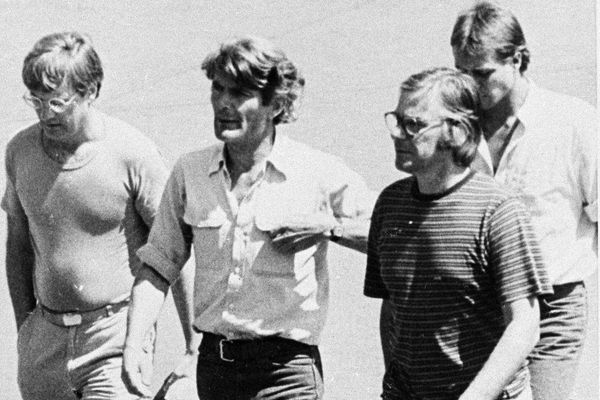
Digitization is transforming construction work. Driving the change are the efforts of Komatsu Ltd., the world's second-largest manufacturer of construction and mining equipment. For this installment of Leaders, a column featuring corporate management and senior executives, Hiroyuki Ogawa, president of Komatsu Ltd., discusses the keys to success.
Companies in our industry are now competing fiercely to corral as many customers as possible onto service platforms, just like the competition among the U.S. IT giants collectively known as GAFA, including Google LLC and Amazon.com Inc.

-- U.S. Caterpillar Inc. is the top company in the construction and mining equipment industry, followed by Komatsu at No. 2. Each company has been trying to attract customers by creating a network that links entire construction workplaces through information and communication technology (ICT). These efforts resemble the situation in which GAFA companies have been drawing users to their own websites and social networking services.
We used to concentrate on creating high-quality products and made selling manufactured products such as bulldozers and hydraulic excavators our core business. This strategy was sustainable back when the demand for construction equipment was rapidly increasing thanks to high economic growth in emerging economies like China.
However, we can't expect such high growth in today's global economy. Selling high-quality machinery alone isn't enough to meet customers' needs. Customers are more strongly demanding that we help improve their productivity and enhance the safety of their employees. That has led us to work on providing support services and solutions that optimize their operations.
For example, in the process of construction and engineering work, we have developed a system that operates drones at construction sites to collect 3D digital topographic data. By linking a 3D blueprint and the drone-collected data, we can easily determine where to dig or fill in dirt. We transmit this information to machinery such as ICT-intensive hydraulic excavators so as to perform precise construction work.
This system allows even inexperienced workers to carry out complex construction work. It would also erase the need for someone to manually demarcate the work zone by placing markers on the site. At many sites, it helped shorten the construction time by about 30%. It's also sure to help with the issue of labor shortages at construction sites.
Sales of construction equipment are affected by economic fluctuations. To ensure stable earnings, it's absolutely necessary to enhance the after-sales services we provide our customers.
Currently, about 560,000 Komatsu construction machines equipped with a GPS device and machine tracking system are operating worldwide.
Komatsu and our distributors, as well as the owners of the equipment, can constantly acquire updated information about the machines including their location, cumulative hours of operation, operating condition and amount of remaining fuel. Whenever a piece of equipment breaks down or any other trouble occurs, a nearby sales agent promptly dispatches staff to the scene to deliver spare parts.
We also utilize the network to predict the best time to deliver spare parts and oil based on how long the machine has been operating, and recommend when to conduct maintenance. This helps prevent malfunctions. Construction work can be completed faster because there are fewer cases of machines failing unexpectedly.
-- Data on construction and mining equipment in operation can also be used as an index of the current state of the economy. Economic analysts are using data provided by Komatsu's construction and mining equipment to assess the economy.
Next spring, we will launch a retrofit kit that enables our conventional hydraulic excavator models to perform ICT functions. We will expand our digital services by taking advantage of ICT-based information. However, we understand that a manufacturer's greatest strength lies in making products. We will continue to enhance our value in terms of both producing superior machines and improving the quality of our services, in order to generate new value for our customers.
Suppliers, not subcontractors
-- Many manufacturers have built their R&D facilities and factories at separate sites. However, Komatsu's R&D base shares the same grounds as its production base.
Today, speed is the key to our business success. Without speeding up our response and improving the value of our services, we can't meet our customer's demands and will miss business opportunities.
Even if an R&D base is separated from a production base by just a few kilometers, the distance actually generates a huge gap in terms of communication. People on both sides often become reluctant to see each other. If everyone is together on the same site, people in charge of product development perform their jobs while listening to the opinions of people on the production side. This improves work efficiency and leads to a higher level of product development.
Maintaining a good relationship with the client companies that make our machine parts is also vital. We do not call them subcontractors. They are our suppliers. When we build a factory overseas, we always ask them to come with us. Our partner companies have to respond to changes in market demand. Once we assign them the production of a certain part, we won't take over their production to make a profit for ourselves even if demand for it increases. We have built trusting relationships with our suppliers by working with them like this for decades.
-- Komatsu operates in about 140 countries, making risk management a challenge.
We have a long-standing custom when making an in-house report: Good news is no news, no news is bad news and bad news is good news.
When we have good news, that's fine. When we have nothing to report, that's a serious problem. Bad news should be reported before anything else because that means there is something we must work on. That's our way of thinking. Our employees always report bad news first on job sites and in the boardroom.
Benefiting customers
For 18 of my 34 years at the company, I was in charge of factory restructuring.
After joining the company, I was first assigned to Kawasaki Plant in Kanagawa Prefecture. In the early 1990s, a sharp decline in market demand in the aftermath of the collapse of the bubble forced the plant to shut down. As the manufacturing engineering head of the staff, I was tasked with restructuring. The employees and production equipment were moved to Mooka Plant in Tochigi Prefecture. I myself was also transfered to that plant from Kawasaki.
Around 2000, the company decided to transfer more employees and factory equipment based at two plants -- in Kashiwazaki in Niigata Prefecture and Kawagoe in Saitama Prefecture -- to the Mooka Plant. I took charge of this restructuring as well.
I gained experience in both transfering and receiving staff and production equipment. Every factory has employees and most of them are from the area around the factory. Some have to take care of their family's rice fields and other crops. They never expected they would have to relocate from their hometown. Many employees voiced their anger over the transfer, saying things like "I don't want to move" or "Why are we closing the plant?" Not a few decided to accept a voluntary retirement offer and left the company. Through this experience of making a decision that affected people's everyday lives, I learned the importance of always thinking about other people's feelings whenever I take action.
From 2014, I served as representative of all our Indonesia operations. At that time, annual orders of mining equipment fell to almost zero from a peak of about 1,000 units because of a sustained plunge in commodity prices.
I worked desperately to pull us out of this plight by repeatedly visiting clients. In so doing, I noticed that people were manually cutting down trees with a chainsaw for wood. I started visiting companies in the forestry industry to suggest introducing machinery to reduce labor-intensive work.
After I left the country, the seed I planted there bore fruit and we are now making a profit from that particular business. I realized that we should constantly consider exactly what clients need, especially when a business hits rock bottom.
One of my favorite sayings is: "Sell not for the sake of selling, sell not what customers like, but sell what benefits customers." This is a business philosophy advocated by Omi merchants [merchants from the Omi area in what is now Shiga Prefecture who achieved success in the Edo period (1603-1867)]. I would like to enhance our presence to the point of becoming indispensable to our customers.
--Hiroyuki Ogawa / President of Komatsu Ltd.
Born in Osaka Prefecture in 1961, Ogawa joined the company after receiving a master's degree in engineering from Kyoto University in 1985. He served in various positions including plant manager in the U.S. and at the Ibaraki Plant as well as the representative of Komatsu's Indonesia operations. After holding such posts as president of the production division, Ogawa took up his current position in April 2019.
--Key numbers: 85%
Komatsu has 72 plants for making construction equipment overseas and 12 in Japan. Overseas sales account for 85% of total sales. According to the consolidated business results for the fiscal year ended March this year, net sales were 2.7252 trillion yen and net income was 256.4 billion yen -- both record highs. The consolidated number of employees was 61,908 as of the end of March.
Read more from The Japan News at https://japannews.yomiuri.co.jp/







